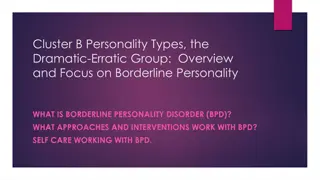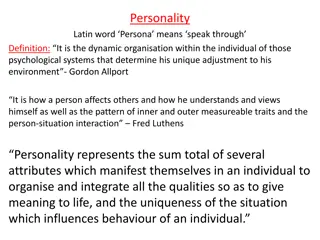
Understanding Communication with Multiple Personalities in Therapy
Learn how to effectively communicate with individuals who have multiple personalities, also known as Dissociative Identity Disorder (DID), during therapy sessions. Discover tips on recognizing different parts, adjusting your communication style, and establishing inner voices for improved dialogue.
Download Presentation

Please find below an Image/Link to download the presentation.
The content on the website is provided AS IS for your information and personal use only. It may not be sold, licensed, or shared on other websites without obtaining consent from the author. If you encounter any issues during the download, it is possible that the publisher has removed the file from their server.
You are allowed to download the files provided on this website for personal or commercial use, subject to the condition that they are used lawfully. All files are the property of their respective owners.
The content on the website is provided AS IS for your information and personal use only. It may not be sold, licensed, or shared on other websites without obtaining consent from the author.
E N D
Presentation Transcript
Healing the Unimaginable Alison Miller, Ph.D.
6 Working with Internal Leaders
A Few Reminders Of how to talk with someone who is multiple
Many Parts (People), One Body We singletons expect to be conversing with one person. But it s more like talking with identical brothers or sisters who impersonate one another, change places fast, and look the same but act differently. Look for the physical evidence of them changing places. Learn to recognize body language and maturity level of different parts. The front person may be just a shell who bridges the transitions so switching is not obvious. Do not assume the front person is the real person and the others less real, or that the front person can control behavior of the other parts Do not assume continuity of memory. Some multiples lie to cover for periods of time they don t remember. Parts new to the present are often confused about time and place and date
Its Like Speaking with Many Housemates on the Phone One at a time can control the voice and speak with you. The house has a speaker phone so those nearby (but not everyone) can hear you. You can talk through to others in the house. You can send messages to ones far from the phone. You can ask that others in the house give information to the one on the phone. You re not really on the phone, but you see the person s body, and you may notice he or she pauses as if listening. If this happens, speak more slowly, pause, and repeat yourself, so that the one you re talking with can talk inside as well as with you. You are actually communicating with several people at once.
Match Your Style to the Part(s) Presenting 7 It s a dance You shift with their state, as with a baby who laughs then cries. It s attunement. You are often talking with an insider when you think it s the front person, the adult. See how old the person appears from their speech and body language, and match your language to that age. Sound assertive with tough parts, but be careful, as even a slightly raised voice can engender terror. Client may ask or think: Are you going to shout? Are you going to hit me? Some tough parts have tender ones hidden underneath the surface. Parts can themselves be multiple.
Using Inner Voices to Establish Communication with Parts 8 Notice when the client seems to be listening internally. Did someone say something to you? What did they say? Do you know what they mean? Could you ask the person who said that why they said that? Can they explain for me? Do they have any questions for me? They can talk through you. Would they be willing to come out and talk to me so I can understand them better?
Attachment Styles of Parts in DID 9 Some parts will act out the type of attachment behavior which worked with their original caregivers. Some other parts will still reach out for the safe, secure attachment which might be possible with you. And you will respond. But be aware that the other parts are present. And many survivors are still involved with the original perpetrators or the group culture to which those perpetrators/parents belonged. There may be intense dependency. And it s very hard for these people to explore, learn and develop a sense of Self. Having had at least one safe attachment tells the child that this is possible, even if it was brief.
Time and Trust There is no substitute for time in building trust. Your clients will watch your every move and every word to see whether or not you are trustworthy, believing that it is most likely that you are not, but hoping desperately that you will prove to be a person they can trust. Take your time, and be patient with yourself, too. At the start, just deal with the presenting problem. The client will let you know when they are ready to go deeper. Treat all parts with consistency and fairness. When new parts emerge, they may have no sense of time. Suggest they talk with parts who have a history with you, so they can catch up on what the other parts have learned about you.
Hierarchies Many organized personality systems have internal hierarchies, which may mirror the structure of the abuser groups. It is easier to work with a hierarchical system than with one which is formed by training individual parts without placing them under any internal authority. With a hierarchy, you can work with the internal leaders who can then shut down any programming until you are able to work with the actual memories which created the programs. When there is little or no hierarchy, lots of internal children will continue to do their jobs, believing in the lies the abusers told them, and fearing abusers who are long gone. The survivor needs to form a new internal government which can seek out these child parts and re-educate them internally and/or work through their training memories.
Internal Leaders are Crucial to Recovery 13 The internal bosses and their enforcers issue threats when the survivor disobeys the rules, and administer punishment for disobedience or disclosures through flashbacks or self-harm or ordering programs to be turned on. To really change things, those parts in charge, at the top of the hierarchy, need to decide to make a break for freedom. Those parts, who rarely if ever come out in everyday life, need to learn about how the survivor s life circumstances have changed, so that in adulthood freedom is possible. The internal leaders also need to discover that they were deceived by the mind controllers, that their power is only internal, and that they do not deserve lifelong slavery.
Sallys Example the Higher-Ups' Statement: 14 We were created to keep everyone [inside] in line so that they would remain loyal to the organizations who made us. They were our family, not the parents, and we owed our lives to them; they were our leaders, fathers, mothers, military trainers, confidantes and family. They would always protect us if we obeyed them and were loyal. From the body s first anointment at birth, we had to keep the body in line via the little ones being told to follow commands, acting like robots for us, and thus not asking or whining or thinking, just doing regardless of the consequences.
Trainers Words to Higher-Ups: 15 Obey or be killed. Obey or suffer. Obey and do. Do not think just do it. You belong to us, you are ours, you are property, to be owned only by us and for our use and no other. We will tell you what to do and when. You will listen or be punished and sent to hell, for God is not the leader here, we are the Luciferians, SS and KKK. Do not deceive us or we will find you and bring you back or dispose of you or make you self-destruct.
Trainers Words to Higher-Ups (continued): 16 For your work little ones, you will be rewarded by not being harmed, thrown into prison, into caves or coffins or killed or tortured or have your friends killed or sacrificed. Obeying and being able to take pain via training makes you stronger and more determined to follow our light, the light of darkness, the way of truth, of light, of power and the superiority and power of the Aryan race over all humans and life. Obey us and be strong and do not let any outsider fool you into believing their lies. You are free with us not with them, you don t need to think, for we think for you and for your safety and your power, so that you may have power over life itself, and the blood of all humanity, and animals. You are superior and will honor us till death or be called a traitor and die with the outsiders in mind, spirit and body. We will make it so.
Facts About Higher-Ups 17 Giving a part a perpetrator name does not mean it wants to become that perpetrator. Many higher-ups have no experience in the real world. They are typically aged 12 or 13. They do not know that the body is an adult now, or that they are far away from the abusers. Their power is only internal. Often they hate the abusers. Higher-ups watch how you treat the lower level insiders.
Beginning to Deal with a Hierarchy 18 If a child part considers stopping his job, he may hear a voice threatening him. When you see your client pause and seem to be listening, s/he may be hearing a warning or a threat. Talk to that voice. Even if it appears to be an internal copy of an abuser, or a fearsome demon, it is a part just like everyone else inside. Ask its age. Make your conversation appropriate for that age group. Do not ask for names, as abusers use them to call out parts for punishment. Reach out with compassion towards increasingly higher levels. Talk to those parts who give threats or punishments such as pain. Be gentle with curiosity; don't interrogate or confront.
Working with the Hierarchy 19 Demonstrate understanding of jobs. Tell them you're an outsider and ask about what they've been told about outsiders. Pacing is crucial; don't go too fast. Get to know each one until it is replaced (in the front) by its boss or backup. Tell them you know that their trust has to be earned. Work to get them to think for themselves.
Dialogue Which Exposes the Deceptions Don't argue with them, join them, agree, point out where & how they are absolutely correct. You can ask (repeatedly) Is that right? Huh. Who told you that?" or "Hmm. I wonder when was the first time you heard that statement?" or Mmm. That's interesting. I wonder who on the outside of you says such things?" or even "You know, you weren't born with that belief, so how did you get that belief? Stay objective, neutral, and matter of fact and curious & interested and wanting to understand. See long examples in my book Becoming Yourself or my article Talking with the higher-ups in Ralf Vogt s book Perpetrator Introjects.
Making Your Way up the Hierarchy 21 If a part considers stopping his job or being disloyal to the abusers, he may be hearing a voice threatening him. When you see your client pause and seem to be listening, he or she may be hearing a warning or a threat. Ask what the client is listening to. If it s a voice, ask what it s saying. Then ask to talk to the voice. Even if it appears to be an internal copy of an abuser, or a fearsome demon, it is a part just like everyone else inside. Ask its age. Make your conversation appropriate for that age. If you convince this voice you are safe, another voice may appear with a different threat or causing a different symptom. Ask to talk to the new one, then do this repeatedly until you get to someone with some authority. Get to know each one until it is replaced by its boss or backup. It takes time. Be content not to know many things for a long time.
Topics for Dialogue What they believe or were taught about outsiders like you Why they believe the group owns them Why they believe they have to obey The truth of what they were taught Safety, protection and freedom (Watch your use of these words, as abusers may have reversed their meanings.)
Unmasking the Deceptions 23 Frequently update the whole system about time and place. Ask parts who know the truth about something to communicate it internally to those who don t. Demonstrate a similar trick to one the abusers used, without abuse. E.g. a mirror with something covering it (Abusers do this to convince a child s/he is a demon.) Write on one part s hand then show it to another part who believes it s in a different body. Have parts together view an event in which they had different parts (e.g. the one the rat was put inside, and the one who believes she gave birth to the rat).
Effects of the Dialogue (according to Sally s internal leaders) 24 Alerting the security system to turn on programs which can make the client appear inaccessible, hostile, or overwhelmed; Making the insiders, including the higher-ups, begin to think for themselves and wonder about the answers to your questions and whether your statements are true; Shaking the foundation of the beliefs indoctrinated into them; Exposing the ways in which they were deceived; Giving the insiders the opportunity to talk on an equal basis with someone who is kind and curious, as opposed to their abusers who gave orders and were cruel; Reducing dissociation by encouraging insiders to obtain information from one another and from the front person.
More Effects of the Dialogue 25 Making the unemotional higher-ups aware of the emotional and physical pain which created them, which is still held in the discarded and lower-down insiders; Making the loyal higher-ups begin to feel or at least be aware of the unmet needs, sadness and loss, and constant fear and anxiety experienced by other insiders; Making memories of hurt insiders accessible to unhurt perpetrator insiders (to end the desire to perpetrate); Helping parts stuck in the past become aware of present-day reality and giving hope for freedom and recovery in the present and future; Getting the head of the system to engage and begin to think; Gradually dissolving the programming; Connecting parts of the person to the person s own spiritual essence, and helping the person regain control over their own life.
Building Inner Community 26 At first, allow those the abuser group put in charge to remain in charge, so there won t be chaos. Teach these internal leaders to use their authority wisely and kindly. Gradually move towards democracy in which the leaders in the governing council represent all parts needs. Research each group of insiders age, likes and dislikes, needs. How could the system provide for their needs in the external world? In the inner world? Insiders often have names which reflect their roles in the abuse; they can choose different names. Costumed insiders can take off the costumes. Those who resemble perpetrators can become kids again. You can ask parts to stop doing harmful jobs. You can ask parts to do their jobs when they are helpful, e.g. put away memories, make everyone forget, help parts stuck in trauma to go to sleep temporarily. Switch controllers and internal programmers can turn off programs, and can provide a list of programs to be dismantled by working through the training memories.
Giving Insiders New Jobs 27 The system can use insiders job skills to assist in recovery. New jobs may resemble old jobs but in the service of help. File keepers can keep memories contained and then bring them up when ready to process them. Observers and recorders can watch the survivor s present life to make sure he or she is safe. Spinners can spin away bad feelings and spin peaceful and calm feelings out into the system. Pain holders can help with medical and dental appointments. Soldier parts can get the body to exercise. Forget program holders can make reporters forget anything they may have been trained to report.
Example: Soldiers vs. Garbage Kids For difficult tasks in the inside or outside world, soldiers are not the best choice. Soldiers are trained in instant obedience to perpetrators. Garbage kids are the ones who refused to act on their training, refused to do what the perpetrators told them to do, even at great personal cost. They are the ones your client wants for tasks which involve standing up to perpetrators.
Ways Parts Can Improve their Inner World 29 Cut wires, destroy control towers, etc. (with permission). Rescue parts who are stuck in inner copies of the places where the abuse occurred: boxes, cages, cold basement rooms, garbage pits, bedrooms where a rapist found them. Give inner kids their own rooms with locks on the inside, comfortable beds or couches, etc. Make nurseries for babies, caregivers, stuffed animals, toys, blankets, pets. Create mansions, tree houses, whatever is most helpful. Make places for exercise, sports, anger release. Create inner TV screens for safely viewing the outer world. Create an inner movie of present-day life to update insiders. Import movie or TV or book characters as helpers, e.g. nannies, doctors.
Ask, Negotiate, Command With some personality systems, asking and negotiating does not work, and verbal commands are necessary with some parts. This is because you are speaking with very young parts who are trained to respond only to commands, often phrased in a particular way. They are concrete and literalistic. They are not offended by commands.
Turn it off! This useful command can with some systems work to get programs which are running temporarily turned off. (Sometimes you need to add in the name of Satan, whom I don t believe in. ) E.g. I command you in the name of Satan, whom I don t believe in, to stop, turn off, and put away the Suicide program. Internal programmers are always listening. If they are afraid to turn a program off, they can turn it down so it is barely noticeable. Spinners can spin in the opposite direction, spinning the effects of the program back to the part it originally affected.
Using Program Codes (See example in Healing the Unimaginable, p. 160) 32 Program codes are sequences of letters and numbers which, when spoken or written correctly, will turn programs on or off or even destroy them. You can obtain codes from the client s internal programmers. Internal programmers are kids who turn apparently electrical switches on and off in response to cues. Knowing codes and saying the off codes can help in undoing programming. It can neutralize programs so they do not get in the way of the therapy. This shortcut does not remove the trauma, just temporarily keeps parts from doing their jobs. You can ask for program lists or charts with their codes (when you get that far and are planning systematic memory work). Much deprogramming is simply using such codes. It does not resolve the trauma.
Two Useful Triggers (for some survivors) Grasping your client s arms firmly and briefly halfway between the shoulders and elbows will turn off a spinning program temporarily. Holding your hands out in front of you, palms upward, then drawing them quickly towards your chest and closing them will temporarily turn off all programs. If you use triggers (e.g. special touches or hand signals), make sure that your client has confirmed what effect they will have and agreed to allow you to use them. Also, explain how you learned these triggers. You can do the triggers on your own body first, to confirm with the client that they are correct and will not do hartm.
Using Programs & Triggers 34 You can use perpetrator-created triggers for useful purposes. No pain can reduce pain from illness or abuse. Sleep can put to sleep parts tired from memory work or programmed to harm the body or go to the group. Forget can keep the memories from the front person so that he or she can function better, or can make a reporter part forget to report. Calling out a particular part can be used in an emergency. Cooperation is always to be preferred to coercion, so ask or suggest rather than just doing such things. If you use triggers, especially without permission, parts may believe you are a perpetrator.
Programs Attached to Places or Events Perpetrator groups can attach programs to particular events or places, e.g. a program may be activated by entering the therapist s office. Programs can be attached to one another (e.g. if a therapist attempts to undo the suicide program it activates the attack therapist program.) As you plan your memory work, you can ask What will happen if we try to undo the Suicide/Pain/Report/Open Door program? What will happen if is a very useful question. If current contact with perpetrators is suspected, you might discuss such linkages by telephone with internal programmers before an appointment. Some parts of the client may be able to make a wiring diagram of how the programs are attached to one another.
Internal Cooperation 36 When the whole personality system works together, and those insiders in charge work for healing, your client can make it all the way to full recovery, given: Careful timing and containment Maintaining current physical safety Updating the parts Encouraging internal communication Memory work when the system is ready A good therapeutic relationship






















